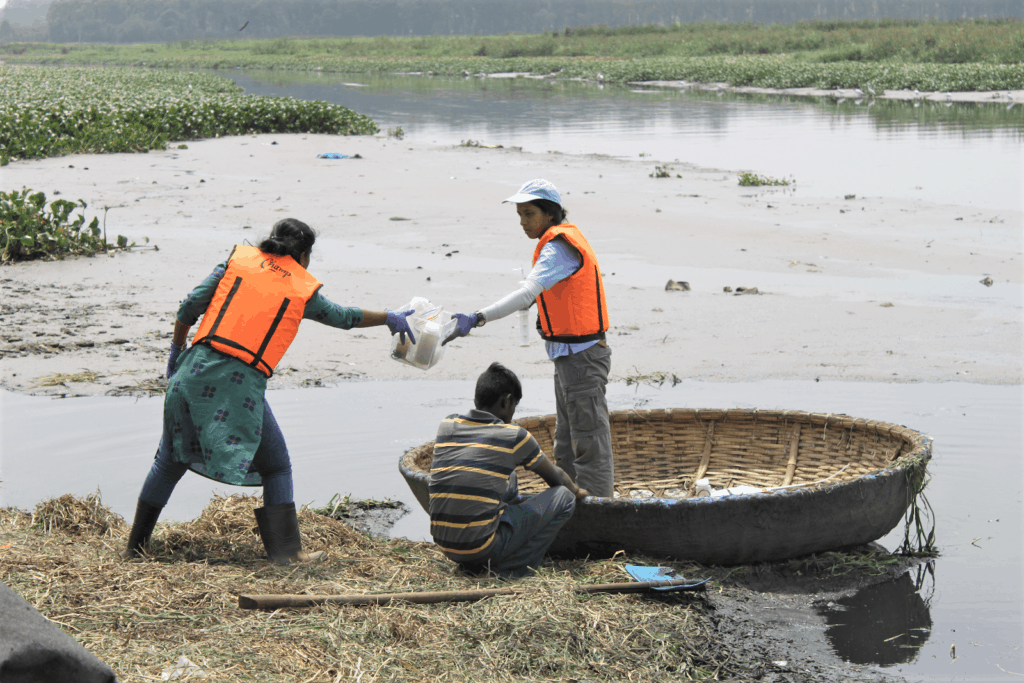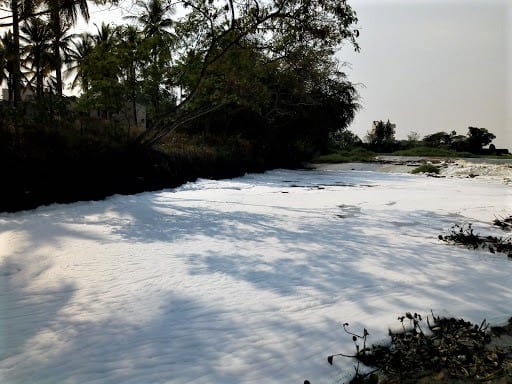Many lakes in Bengaluru, such as Kaikondrahalli, Kasavanahalli and Kalkere lakes, have foamed before. But the quantity of foam in Varthur and Bellandur lakes are alarmingly high.
In our previous article, we saw that fire occurs in Bellandur and Varthur lakes mainly because about 40% of the city’s sewage is discharged into the catchment areas of these lakes. Apart from sewage, industrial effluents and solid waste are also dumped into these lakes. In some circumstances, this can cause the formation of foam.
Foam in both Bellandur and Varthur lakes usually form during the pre-monsoon and monsoon season, when there are heavy rains and wind. The foam sometimes overflows onto the road, causing roadblocks and hindering the view of motorists. Some residents in the area have said the foam causes skin irritation, and that the chemicals in it are toxic. That is, foam from lakes is not only a public nuisance, but also a public health threat.

Pic: whitefieldrising.org
What causes foam?
Following is a lake system map that points to the root causes of foam in Bengaluru’s lakes.

Foam forms on the surface of lakes when the surface tension between air and water molecules is reduced. Lower surface tension allows air molecules to mix more easily with water molecules and create bubbles, which then collect to form foam.
What reduces surface tension though?
- Chemical surfactants (Surfactants are compounds that lower surface tension, and usually act as detergents, wetting agents, etc.),
- biological surfactants or
- filamentous bacteria,
that come from the discharge of raw sewage or industrial effluents into lakes.
Chemical surfactants
The main source of chemical surfactants are the detergents used at homes and the effluents from detergent and soap manufacturing industries. Surfactants and phosphates are used in making detergent so as to create foaming and improve cleaning efficiency. Since phosphates increase the efficacy of surfactants, they exacerbate the formation of foam in lakes. Phosphates found in detergents are not biodegradable and can result in persistent foam.
Some foreign countries have totally banned the use of phosphate in detergents. But in India, most detergents still contain these. Phosphates in detergents have had a huge impact on Bengaluru’s lakes, as evidenced in a 2015 study by the Centre for Ecological Sciences at the Indian Institute of Science.
Biological surfactants
These form when nutrient-rich sewage enters the lake. Microorganisms feed on the organic matter in sewage and attach itself to the organic sediments. They release extra polymer substrates (EPS) for binding and creating a thin film over the surface of the lake bed, i.e., biofilms.

EPS is a natural biological surfactant and phosphates enhance the activity of biological surfactants too. These biological surfactants get dislodged during rain events or by churning/ turbulence of the water, which leads to the formation of stable white foam.
Filamentous bacteria
Filamentous bacteria are long strands of bacteria growing end to end, resembling strands of hair or spaghetti. They rapidly multiply and dominate the water environment when there is a sudden decline in the organic matter levels, which happens during pre-monsoon showers and in summer when temperatures are high. The thin strands of filamentous bacteria reduce surface tension in water, leading to the formation of foam.
What’s happening with Bellandur and Varthur lakes
Varthur and Bellandur lakes have foamed several times. But the first time the issue garnered international attention was in May 2015, when Bellandur lake was filled with foam and subsequently caught fire twice that month.
In March 2019, Varthur lake foamed near its outlets. Foam is usually seen in the lake during monsoons, so residents were alarmed to see it during the summer months and complained of foul smell. Two months before, BDA, the lake custodian, had installed sluice gates to reduce sewage inflow, yet it failed to stop the formation of foam in the lake.

The frequent foaming and fire led to public outcry. Initially, different government authorities (BDA, BBMP, BWSSB and KSPCB) simply blamed each other for pollution in both lakes. In 2017, the National Green Tribunal set up a committee of experts to draft an inspection report and a rejuvenation plan for the lakes. In the rejuvenation plan, the responsibilities of each government body is clearly listed, and they are made accountable for the tasks they need to complete.
What to do when you see foam in your lake
When you see foam, inform your lake custodian of where you see it forming. If you do not know your lake custodian, you can contact BBMP through phone on 080-22660000 or through email at contactusbbmp@gmail.com.
How to prevent foam
Top-down measures
- Deploy centralised Wastewater Treatment Plants to treat domestic and industrial wastewater separately
- Deploy constructed wetlands to remove excess organic matter/nutrients from the secondary treated effluents, before it enters the lake
- Map and Identify hotspots, and setup water quality monitoring downstream of hotspots in the lake catchment area
- Set up realistic water quality, biodiversity goals for restoration projects
- After desilting (removal of anaerobic sediments and biofilms from the lake bed), allow treated effluent into the lake
- Government can control pollution from detergents by regulating the type of surfactants and phosphate content that can be used in them. Phosphate-based detergents should be replaced with less harmful chemicals.
Bottom-up measures
- Lake groups can help with the operation and maintenance of constructed wetlands, and also help monitor the quality of effluents passing through it.
- You can make a difference by learning more about the ingredients in your household cleaning products and shifting to eco-friendly products such as detergents made with soap nuts and plant-derived enzymes.

This is a nice write-up. The authorities may have used the lockdown period to remove the weeds covering the lake and desilt the lake. The chemical composition of the sediment removed needs to be studied in detail, as it would still contain high levels of toxic chemicals and heavy metals that can be absorbed by plants and crops. So, extreme care should be taken while dumping the sediment and before it is used for activities such as farming. In some cases, the lake sediment had to be treated again for reuse in farms.
Hi Citizenmatters team,
Thanks for the write up.
Could you please do an article on current status of cleanup of Bellandur lake. Not sure if the contractor and BDA are in the right direction.
Common citizen do not understand the bigger picture of what’s going good and what’s going bad. Request to do a feature on the same.